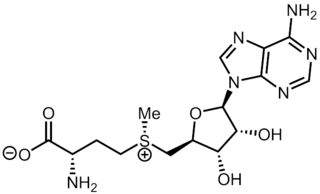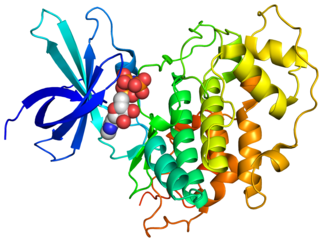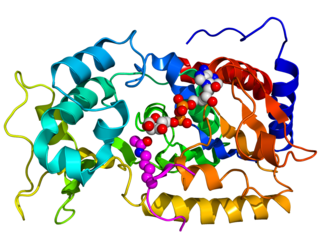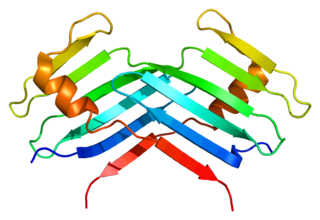Related Research Articles

Methionine is an essential amino acid in humans.

S-Adenosyl methionine (SAM), also known under the commercial names of SAMe, SAM-e, or AdoMet, is a common cosubstrate involved in methyl group transfers, transsulfuration, and aminopropylation. Although these anabolic reactions occur throughout the body, most SAM is produced and consumed in the liver. More than 40 methyl transfers from SAM are known, to various substrates such as nucleic acids, proteins, lipids and secondary metabolites. It is made from adenosine triphosphate (ATP) and methionine by methionine adenosyltransferase. SAM was first discovered by Giulio Cantoni in 1952.
A salvage pathway is a pathway in which a biological product is produced from intermediates in the degradative pathway of its own or a similar substance. The term often refers to nucleotide salvage in particular, in which nucleotides are synthesized from intermediates in their degradative pathway.

Glycogen synthase kinase 3 (GSK-3) is a serine/threonine protein kinase that mediates the addition of phosphate molecules onto serine and threonine amino acid residues. First discovered in 1980 as a regulatory kinase for its namesake, glycogen synthase (GS), GSK-3 has since been identified as a protein kinase for over 100 different proteins in a variety of different pathways. In mammals, including humans, GSK-3 exists in two isozymes encoded by two homologous genes GSK-3α (GSK3A) and GSK-3β (GSK3B). GSK-3 has been the subject of much research since it has been implicated in a number of diseases, including type 2 diabetes, Alzheimer's disease, inflammation, cancer, addiction and bipolar disorder.
Cancer research is research into cancer to identify causes and develop strategies for prevention, diagnosis, treatment, and cure.
In oncology, the Warburg effect is the observation that most cancer cells release energy predominantly not through the 'usual' citric acid cycle and oxidative phosphorylation in the mitochondria as observed in normal cells, but through a less efficient process of 'aerobic glycolysis' consisting of a high level of glucose uptake and glycolysis followed by lactic acid fermentation taking place in the cytosol, not the mitochondria, even in the presence of abundant oxygen. This observation was first published by Otto Heinrich Warburg, who was awarded the 1931 Nobel Prize in Physiology for his "discovery of the nature and mode of action of the respiratory enzyme". The precise mechanism and therapeutic implications of the Warburg effect, however, remain unclear.

Sirtuins are a family of signaling proteins involved in metabolic regulation. They are ancient in animal evolution and appear to possess a highly conserved structure throughout all kingdoms of life. Chemically, sirtuins are a class of proteins that possess either mono-ADP-ribosyltransferase or deacylase activity, including deacetylase, desuccinylase, demalonylase, demyristoylase and depalmitoylase activity. The name Sir2 comes from the yeast gene 'silent mating-type information regulation 2', the gene responsible for cellular regulation in yeast.
Histone methylation is a process by which methyl groups are transferred to amino acids of histone proteins that make up nucleosomes, which the DNA double helix wraps around to form chromosomes. Methylation of histones can either increase or decrease transcription of genes, depending on which amino acids in the histones are methylated, and how many methyl groups are attached. Methylation events that weaken chemical attractions between histone tails and DNA increase transcription because they enable the DNA to uncoil from nucleosomes so that transcription factor proteins and RNA polymerase can access the DNA. This process is critical for the regulation of gene expression that allows different cells to express different genes.

Methyltransferases are a large group of enzymes that all methylate their substrates but can be split into several subclasses based on their structural features. The most common class of methyltransferases is class I, all of which contain a Rossmann fold for binding S-Adenosyl methionine (SAM). Class II methyltransferases contain a SET domain, which are exemplified by SET domain histone methyltransferases, and class III methyltransferases, which are membrane associated. Methyltransferases can also be grouped as different types utilizing different substrates in methyl transfer reactions. These types include protein methyltransferases, DNA/RNA methyltransferases, natural product methyltransferases, and non-SAM dependent methyltransferases. SAM is the classical methyl donor for methyltransferases, however, examples of other methyl donors are seen in nature. The general mechanism for methyl transfer is a SN2-like nucleophilic attack where the methionine sulfur serves as the leaving group and the methyl group attached to it acts as the electrophile that transfers the methyl group to the enzyme substrate. SAM is converted to S-Adenosyl homocysteine (SAH) during this process. The breaking of the SAM-methyl bond and the formation of the substrate-methyl bond happen nearly simultaneously. These enzymatic reactions are found in many pathways and are implicated in genetic diseases, cancer, and metabolic diseases. Another type of methyl transfer is the radical S-Adenosyl methionine (SAM) which is the methylation of unactivated carbon atoms in primary metabolites, proteins, lipids, and RNA.
RNA activation (RNAa) is a small RNA-guided and Argonaute (Ago)-dependent gene regulation phenomenon in which promoter-targeted short double-stranded RNAs (dsRNAs) induce target gene expression at the transcriptional/epigenetic level. RNAa was first reported in a 2006 PNAS paper by Li et al. who also coined the term "RNAa" as a contrast to RNA interference (RNAi) to describe such gene activation phenomenon. dsRNAs that trigger RNAa have been termed small activating RNA (saRNA). Since the initial discovery of RNAa in human cells, many other groups have made similar observations in different mammalian species including human, non-human primates, rat and mice, plant and C. elegans, suggesting that RNAa is an evolutionarily conserved mechanism of gene regulation.

Serine/threonine-protein kinase PAK 1 is an enzyme that in humans is encoded by the PAK1 gene.

Low density lipoprotein receptor-related protein 1 (LRP1), also known as alpha-2-macroglobulin receptor (A2MR), apolipoprotein E receptor (APOER) or cluster of differentiation 91 (CD91), is a protein forming a receptor found in the plasma membrane of cells involved in receptor-mediated endocytosis. In humans, the LRP1 protein is encoded by the LRP1 gene. LRP1 is also a key signalling protein and, thus, involved in various biological processes, such as lipoprotein metabolism and cell motility, and diseases, such as neurodegenerative diseases, atherosclerosis, and cancer.

Serine/threonine-protein kinase PAK 4 is an enzyme that in humans is encoded by the PAK4 gene.

Serine/threonine-protein kinase PLK4 also known as polo-like kinase 4 is an enzyme that in humans is encoded by the PLK4 gene. The Drosophila homolog is SAK, the C elegans homolog is zyg-1, and the Xenopus homolog is Plx4.

Pyruvate kinase isozymes M1/M2 (PKM1/M2), also known as pyruvate kinase muscle isozyme (PKM), pyruvate kinase type K, cytosolic thyroid hormone-binding protein (CTHBP), thyroid hormone-binding protein 1 (THBP1), or opa-interacting protein 3 (OIP3), is an enzyme that in humans is encoded by the PKM2 gene.
Wafik El-Deiry is an American physician and cancer researcher who is the Associate Dean for Oncologic Sciences at the Warren Alpert Medical School, Brown University, Director of the Cancer Center at Brown University, and the Director of the Joint Program in Cancer Biology at Brown University and its affiliated hospitals. He was previously deputy director of Translational Research at Fox Chase Cancer Center, where he was also co-Leader of the Molecular Therapeutics Program.

In molecular biology, miR-137 is a short non-coding RNA molecule that functions to regulate the expression levels of other genes by various mechanisms. miR-137 is located on human chromosome 1p22 and has been implicated to act as a tumor suppressor in several cancer types including colorectal cancer, squamous cell carcinoma and melanoma via cell cycle control.

SET domain containing 6 is a protein in humans that is encoded by the SETD6 gene.
DNA methylation in cancer plays a variety of roles, helping to change the healthy cells by regulation of gene expression to a cancer cells or a diseased cells disease pattern. One of the most widely studied DNA methylation dysregulation is the promoter hypermethylation where the CPGs islands in the promoter regions are methylated contributing or causing genes to be silenced.
Anjana Rao is a cellular and molecular biologist of Indian ethnicity, working in the US. She uses immune cells as well as other types of cells to understand intracellular signaling and gene expression. Her research focuses on how signaling pathways control gene expression.
References
- ↑ "Jason Locasale: Fighting cancer with chemical complexity and collaboration". The Chronicle. Retrieved 2019-12-01.
- ↑ "Speaker: Cell Symposia: Metabolites as Signalling Molecules". www.cell-symposia.com. Retrieved 2019-12-01.
- ↑ "Jason Locasale | Duke School of Medicine". medschool.duke.edu. Retrieved 2019-12-01.
- ↑ Liu, Xiaojing; Ser, Zheng; Locasale, Jason W (2014-02-18). "Development and Quantitative Evaluation of a High-Resolution Metabolomics Technology". Analytical Chemistry. 86 (4): 2175–2184. doi:10.1021/ac403845u. ISSN 0003-2700. PMC 3983012 . PMID 24410464.
- ↑ "Cancer Metabolism: A Conversation with Jason Locasale". National Cancer Institute. 2016-11-28. Retrieved 2019-12-01.
- ↑ Locasale, Jason W. (August 2013). "Serine, glycine and one-carbon units: cancer metabolism in full circle". Nature Reviews Cancer. 13 (8): 572–583. doi:10.1038/nrc3557. ISSN 1474-1768. PMC 3806315 . PMID 23822983.
- ↑ Gao, Xia; Lee, Katie; Reid, Michael A.; Sanderson, Sydney M.; Qiu, Chuping; Li, Siqi; Liu, Juan; Locasale, Jason W. (2018-03-27). "Serine Availability Influences Mitochondrial Dynamics and Function through Lipid Metabolism". Cell Reports. 22 (13): 3507–3520. doi:10.1016/j.celrep.2018.03.017. ISSN 2211-1247. PMC 6054483 . PMID 29590619.
- ↑ Locasale, Jason W.; Grassian, Alexandra R.; Melman, Tamar; Lyssiotis, Costas A.; Mattaini, Katherine R.; Bass, Adam J.; Heffron, Gregory; Metallo, Christian M.; Muranen, Taru; Sharfi, Hadar; Sasaki, Atsuo T. (September 2011). "Phosphoglycerate dehydrogenase diverts glycolytic flux and contributes to oncogenesis". Nature Genetics. 43 (9): 869–874. doi:10.1038/ng.890. ISSN 1546-1718. PMC 3677549 . PMID 21804546.
- ↑ Reid, Michael A.; Allen, Annamarie E.; Liu, Shiyu; Liberti, Maria V.; Liu, Pei; Liu, Xiaojing; Dai, Ziwei; Gao, Xia; Wang, Qian; Liu, Ying; Lai, Luhua (2018-12-21). "Serine synthesis through PHGDH coordinates nucleotide levels by maintaining central carbon metabolism". Nature Communications. 9 (1): 5442. Bibcode:2018NatCo...9.5442R. doi: 10.1038/s41467-018-07868-6 . ISSN 2041-1723. PMC 6303315 . PMID 30575741.
- ↑ Mehrmohamadi, Mahya; Liu, Xiaojing; Shestov, Alexander A.; Locasale, Jason W. (2014-11-20). "Characterization of the Usage of the Serine Metabolic Network in Human Cancer". Cell Reports. 9 (4): 1507–1519. doi:10.1016/j.celrep.2014.10.026. ISSN 2211-1247. PMC 4317399 . PMID 25456139.
- ↑ Liberti, Maria V.; Locasale, Jason W. (March 2016). "The Warburg Effect: How Does it Benefit Cancer Cells?". Trends in Biochemical Sciences. 41 (3): 211–218. doi:10.1016/j.tibs.2015.12.001. ISSN 0968-0004. PMC 4783224 . PMID 26778478.
- ↑ Liberti, Maria V.; Dai, Ziwei; Wardell, Suzanne E.; Baccile, Joshua A.; Liu, Xiaojing; Gao, Xia; Baldi, Robert; Mehrmohamadi, Mahya; Johnson, Marc O.; Madhukar, Neel S.; Shestov, Alexander A. (2017-10-03). "A Predictive Model for Selective Targeting of the Warburg Effect through GAPDH Inhibition with a Natural Product". Cell Metabolism. 26 (4): 648–659.e8. doi:10.1016/j.cmet.2017.08.017. ISSN 1932-7420. PMC 5629112 . PMID 28918937.
- ↑ Mentch, Samantha J.; Mehrmohamadi, Mahya; Huang, Lei; Liu, Xiaojing; Gupta, Diwakar; Mattocks, Dwight; Gómez Padilla, Paola; Ables, Gene; Bamman, Marcas M.; Thalacker-Mercer, Anna E.; Nichenametla, Sailendra N. (2015-11-03). "Histone Methylation Dynamics and Gene Regulation Occur through the Sensing of One-Carbon Metabolism". Cell Metabolism. 22 (5): 861–873. doi:10.1016/j.cmet.2015.08.024. ISSN 1550-4131. PMC 4635069 . PMID 26411344.
- ↑ "High-Throughput Epigenetics Analyses". The Scientist Magazine®. Retrieved 2019-12-08.
- ↑ "Potentially reversible changes in gene control 'prime' pancreatic cancer cells to spread: Epigenetic changes, not DNA mutations, drive some metastasis". ScienceDaily. Retrieved 2019-12-25.
- ↑ "How a dietary change might boost cancer therapy". Medical News Today. 4 August 2019. Retrieved 2019-12-25.
- ↑ "Vegan diets may help boost cancer treatments". KAMR - MyHighPlains.com. 2019-08-06. Retrieved 2019-12-25.
- ↑ Says, Dyljohbar (2019-07-31). "Going vegan 'really can prevent cancer'". The London Economic. Retrieved 2019-12-28.
- ↑ Kahn, Joel (2019-08-05). "A Low Methionine Diet: New Data for Cancer Therapy Favors Plant Foods". Medium. Retrieved 2019-12-28.
- ↑ Hamblin, James (2019-05-20). "You Can't 'Starve' Cancer, but You Might Help Treat It With Food". The Atlantic. Retrieved 2019-12-08.
- ↑ "Altering Diet to Enhance Cancer Treatment Response". National Cancer Institute. 2019-09-03. Retrieved 2019-12-13.
- ↑ Stern, Adam Philip (2019-06-17). "Feeding the Beast: Could Eating the Right Diet Starve Cancers Like Mine?". Medium. Retrieved 2019-12-01.
- ↑ "Can diet help cancer treatment? Study in mice offers clues". news.yahoo.com. Retrieved 2019-12-08.
- ↑ "Mice fed a low-methionine diet respond better to cancer treatments". Chemical & Engineering News. Retrieved 2019-12-08.
- ↑ "HOME". Locasale Lab. Retrieved 2019-12-01.
- 1 2 "Editorial Board". Cell Stress. 1970-01-01. ISSN 2523-0204.
- ↑ "Deciphering cancer: The intersection of epigenetics, metabolism, and tumorigenesis". Science | AAAS. 2017-02-21. Retrieved 2019-12-01.
- ↑ "PLOS Biology: A Peer-Reviewed Open-Access Journal". journals.plos.org. Retrieved 2019-12-01.
- ↑ "Oncotarget | Editorial Board/Editors". www.oncotarget.com. Retrieved 2020-01-03.
- ↑ "NCI F99/K00 Award". National Cancer Institute. 2015-12-29. Retrieved 2019-12-18.
- ↑ "Student Honors and Laurels for 2019". today.duke.edu. Retrieved 2019-12-18.
- ↑ "School of Medicine Faculty Recognized on 'Highly Cited' List | Duke School of Medicine". medschool.duke.edu. Retrieved 2019-12-01.
- ↑ "Highly Cited Researchers". publons.com. Retrieved 2019-12-01.
- ↑ "Global List of Highly Cited Puts Duke in Top Ten". today.duke.edu. Retrieved 2019-12-25.